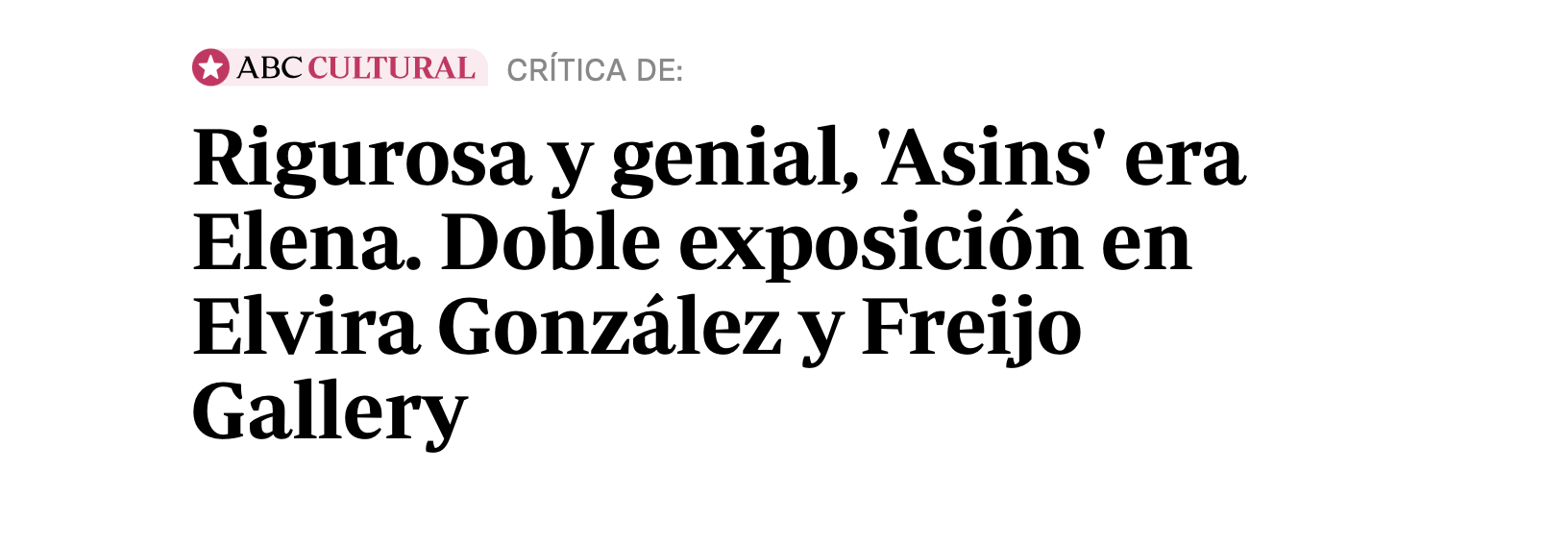"GEOMETRIC VARIATIONS" ON ABC CULTURAL
April 6, 2024
Rigorous and brilliant, "Asins" was Elena. Double exhibition at Elvira González and Freijo Gallery
ABC Cultural - 4/4/24 - Nerea Ubieto
Something disturbs the viewer's attention if he or she observes Elena Asins' exhibition at the Elvira González gallery exhaustively, a minimal correction at the end of the neat tour of one of the works. It is not that the retouching with a tracing pen altered the general harmony of the composition, most will not notice it, but I can imagine the disturbance it caused for the artist.
Rigorous to the point of obsession, a lover of structure, the numerical and the rational, Asins sought to construct a perfect world (her own), far removed from miscalculation and, of course, the emotional. His body of work, varied in formats and strategies, responds to this objective and materialises with categorical features: a computational base, minimalist, geometric and methodological aesthetics, always in black and white, absolute formal purification, the appearance of a pentagram with an inherent rhythm and, above all, compositions that follow a mathematical logic: "My work generates itself because it starts from an equation". The individual exhibition shows a splendid selection of large works on paper, from the late 1970s to the early 1990s, which reflect his genuine style with elegance, simplicity and asceticism.
Looking up
We see several series with their variations ('Zettel', 'Canons') and pieces shown to the public for the first time: 'Ying-Yang', from 1980 (don't forget to look at the ceiling if you want to enjoy the frieze from 64 pages); 'Dia-theke', from 1988-1991, or 'E70 KV589' (1980), a nine-metre cardboard that impacts and imbues the spectator with its creative process. In this sense, all the works function more as a graphic reading than as a plastic experience.
There is something playful in the configurations that invite the observer to look for the formula that generates the difference in the next variation. The procedure demands time, a crucial element in the understanding of his work: passing, mutation and memory are constants that he shares with music.
Without moving from the capital, the Freijo gallery also exhibits the artist promoter of cybernetic art, but in dialogue with another tireless worker, the French Ode Bertrand (1930). Although the starting points are very different - Bertrand's work is geometric abstraction without the use of the computer - there are evident links and resonances: order, meticulousness, the predominance of black and white and the line, subtle interactions, repetition and musicality.
Double exhibition of Elena Asins in Madrid
Elvira González Gallery. Madrid. C/ Hermanos Álvarez Quintero, 1. Until 14 May. Four stars.
Asins & Bertrand. 'Geometric Variations'. Freijo Gallery. Madrid. C/ Zurbarán, 46. Until 4 May. Four stars.
There are more pieces by Bertrand, from the 80s to the present day (the artist is still active at the age of 94); by Asins, we find works a little later than those by Elvira González, see the 'Prussian Quartets' (1997), metal on wood in honour of Mozart, or the 'Dolmens' (1994), 'collages' that connect with the artist's more spiritual side, the one that aspired to transcendence.

